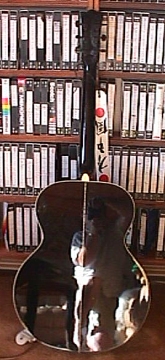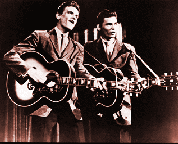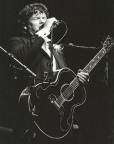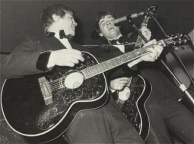
Bill Hillman Guitar No. 17
Yamaha Black Jumbo
Electro-Acoustic FJ681
Serial No. 40517538
www.hillmanweb.com/hillgt17.html
.
.
Ever since working with the Everly Brothers in the early '60s I have been a devoted fan of their harmonies . . . and their black Gibson guitars. Since buying a vintage Everly guitar was out of my price range, I recently did the next best thing a few years ago — I answered an add placed by a pensioner and former-jazz-player and bought his sunburst Gibson acoustic, but it really didn't look or feel much like an Everly. So, soon after this purchase I ordered a Yamaha black jumbo which looked much like an Everly Gibson -- sort of a poor man's Everly model. I have used this easy-to-amplify acoustic for most of our recent small gigs where we perform without the full band line-up.We have done a number of folk festivals and ethnic concerts in recent years where it has been a treat to work with our kids. First born, Ja-On has played sax in rock bands and he now teaches the instrument at a local music studio. Son, Robin, besides playing trombone in the Brandon University Jazz Band and drums on many of our stage shows, also has a keen interest in Celtic music and looks forward to playing bodhran drums on our acoustic shows. Daughter China-Li, drawing from her Scottish roots, is an even more avid student of all things Celtic. Besides playing piano, synths, drums, guitar, trombone -- she is an excellent harpist and bagpipe player, and highland dancer. The booming sound of my Yamaha acoustic seems to fit in quite nicely with our Celtic explorations. In keeping with my appreciation of all things Chinese, as well as Celtic, I offset the shiny black finish of this flat-top by adding a white strap decorated with Asian characters.
Interestingly, this guitar was the one used by Randy Bachman, much of the time, on their re-union tours and TV special.
By David Simon
Ref: Acoustic Guitar CentralWhen it comes to the unmistakable acoustic sound of the Everly Brothers, size matters. For their live work, the brothers lugged around a pair of mid-1950s sunburst Gibson J-200s, although Don says that a 1953 Gibson Southern Jumbo powers those ’50s Cadence tracks. "That was my first guitar," he notes, "the one my dad got for me in Knoxville. I’ve still got it right here." The SJ’s extra big box was especially handy for all those low-tech, one-mic affairs.
At the height of their popularity in the early ’60s, the Everlys designed a guitar in conjunction with Gibson that addressed some of the most persistent problems they’d encountered. First introduced in 1962, the Gibson Everly Brothers model—featuring a trend-setting black finish—was slightly smaller than the J-200 (16 inches wide instead of 17 across the lower bout), but its maple back and sides and X-braced top offered the same distinctive tone. To protect against the brothers’ vigorous strumming, Don devised double tail-fin pickguards that extended below the bridge.
Meanwhile Phil, a perpetual string breaker, suggested a pinless bridge based on the string-routing system of Fender electrics. (Phil’s wire-busting habit would ultimately lead to his 1995 formation of the Everly Music Co., an enterprise dedicated to the production of longer-lasting guitar and bass strings.)
Gibson stopped manufacturing the EB model in 1972 (although it was reintroduced in altered form as the J-180 in 1986), right around the time that Phil ran into a young luthier by the name of Robert Steinegger (PO Box 25304, Portland, OR 97298; steiny@aracnet.com). Phil had been dissatisfied with a repair job on one of his EB models and gave Steinegger the chance to undo the damage. The Everlys would split shortly after Steinegger delivered the refurbished guitar to a highly satisfied Phil, but a decade later Steinegger and the younger Everly would meet again.
On the verge of the Everlys’ London reunion concert, Phil asked Steinegger if he could build a pair of new guitars based on the style of the Gibson EB. Steinegger obliged—and thus was born the Steinegger Ike Everly model. In the years since, Steinegger has cooked up some 50 Ike models (two of which currently reside in the homes of Paul McCartney and George Harrison—both recent gifts from Phil), as well as a one-shot D-50—a special version of the Ike Everly guitar made of ebony back and sides that features more than a pound of gold inlay. Phil presented this guitar to his brother Don on his 50th birthday in 1987.










